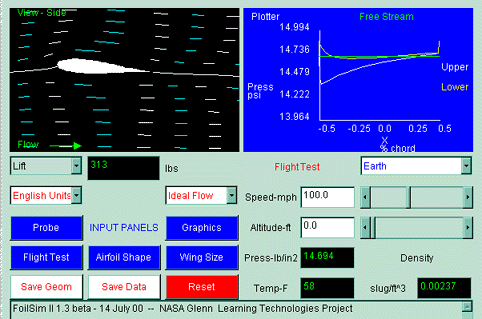
|
Showing the Lift Equation
in its Y = mX + b Form
|

|
Subject Area: Physics
Grade Level: 11 - 12
National Science Standards:
- Select and apply technology tools for research, information
analysis, problem-solving, and decision-making in content
learning.
- Investigate and apply simulations in real-world
situations.
National Technology Standards:
- Technology research tools: Use content-specific tools,
software and simulations (e.g., environmental probes, graphing
calculators, exploratory environments, Web tools) to support
learning and research; select and use appropriate tools and
technology resources to accomplish a variety of tasks and solve
problems.
- Problem-Solving and Decision-Making Tools - Routinely
and efficiently use on-line information resources to meet needs
for collaboration, research, publications, communications, and
productivity.
Objective:
- After reading an explanation from a NASA Web-based textbook,
you will demonstrate an understanding of the text by using it,
along with FoilSim, to complete an activity that manipulates the
lift coefficient equation to solve for lift as a function of angle
of attack, and interpret the complete lift equation.
FoilSim is an interactive
simulation software package that examines the airflow around various shapes
of airfoils. As you change parameters such as airspeed, altitude, angle
of attack, thickness and curvature of the airfoil, and size of the wing
area, the software calculates the lift. The package was created at the NASA
Glenn Research Center.
FoilSim II is a Java applet program that executes inside the browser of your computer.
It is available on the World Wide Web at
http://www.grc.nasa.gov/WWW/K-12/airplane/foil2.html.
You can also
download the program to run off-line.
Shown below is a screen
shot from the program's controls and displays. You may change the values
of the variables by using the slider or the input box on the left of the
slider.
To use the slider:
- Click the mouse
pointer on the arrows at the ends of the slider.
- Click the mouse
pointer anywhere between the slider and the arrow.
- Drag the slider
with the mouse.
To use the input
box:
Simply select the
value in the input box, key in the new value, and press Enter or Tab when
finished. The button on the slider will move corresponding to the value
typed in the box.

You will study how lift varies with airfoil shape and also angle
of attack. Backround information can be found at:
basic lift equation
airfoil shape
angle of attack
Assessment:
You and your partner(s) will be evaluated on the accuracy
and completeness of your answers.
Evaluation:
You will demonstrate your understanding and use of the
complete lift equation by solving it in its linear form and
applying this equation as a function of angle of attack, in
graphical form.
Submitted by: Gary Ruschel, University of Akron, Cleveland,
Ohio.
|
